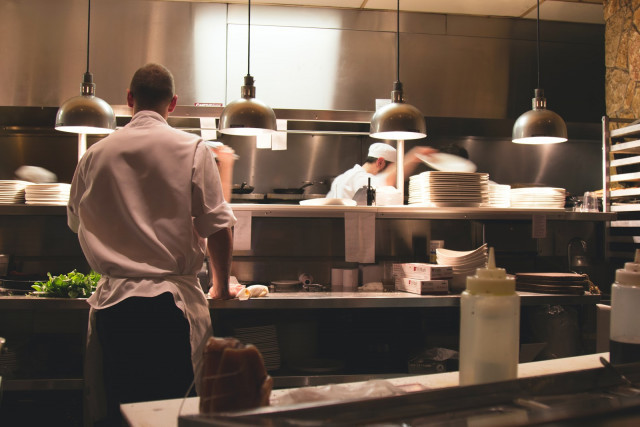It’s a weeknight. You woke up early to get a head start on the day and, after working late, you’re finally returning home. You begin to settle in and then an empty rumbling feeling reminds you: You forgot to make plans for dinner.
You check the fridge, nothing. You could hop in your car and go find a bite to eat, but honestly, it’s been a long day and you just want to kick your feet up and relax. Embracing the laziness, you grab your phone and open one of the many food-delivery services you’ve downloaded, you begin to scroll.
Soon a plethora of cuisine options are before your eyes, all promising to be delivered right to your doorstep. Names of restaurants you’re both familiar and unfamiliar with are at your fingertips. You make your choice, press order, and in 30 minutes there’s a ring at your doorbell. Dinner is served.
As you’re enjoying your food, the thought passes in your head that you’ve never seen this restaurant around town. But you keep eating, never realizing you ordered from a ghost kitchen.
What is a ghost kitchen?
Contrary to what the name suggests, there is nothing paranormal or spooky about ghost kitchens. Instead, it’s a space where a restaurant has set up a kitchen strictly for delivery purposes. “It does not include any consumer-facing physical space like a dining room or pick-up counter or window,” explained Johnson & Wales associate professor and online instructor Brian Warrener. “Instead, it is frequently connected to one or more ‘virtual restaurants’ which are restaurants with names, concepts, cuisines, and stories that exist only through their menus and their online identities.”
According to Restaurant Business Online, the lure of ghost kitchens for businesses is to cut the cost of having to run an entire dine-in experience and, instead, focus on serving up the same quality food for delivery only. With this type of business model, Warrener believes that this is a win-win for both the business and the consumer. “Savings can be passed on to the consumer. Also, the lower capital needs for opening, as well as the ability to offer more menus, can significantly expand the variety of foods offered in a given area.”
Who is creating ghost kitchens?
Even if you’re new to understanding the concept of ghost kitchens, you’re probably already familiar with a few brands that have gotten in on the game. In May of 2020, the veil behind restaurants operating as ghost kitchens was lifted when it became known that the popular family restaurant Chuck E. Cheese was also going by the name Pasqually’s Pizza & Wings on food-delivery services.
This revelation got many people curious about other companies that may be utilizing this tactic, and, as it turns out, many other well-known restaurants are in the ghost-kitchen game. Applebee’s operates a sub-brand named Neighborhood Wings by Applebee’s. Just Salad, a chain of fast-food restaurants that offers healthy alternatives, runs a virtual brand named Health Tribes.
Meanwhile in India, Wendy’s, a largely US-based fast-food chain that has yet to expand much internationally and is leagues behind competitors like McDonald’s and Burger King in this feat, is skipping opening traditional restaurants in the country and instead of opening hundreds of ghost kitchens. They’re committed to opening 250 ghost kitchens and only 150 traditional restaurants throughout the country.
Passing trend or here to stay?
While some may argue that the rise of ghost kitchens will fade and traditional dining experiences will prevail, others disagree, citing consumers have begun to reprogram how they think about food and restaurants. “American consumers have become increasingly comfortable with purchasing food and beverage for consumption off-premise via either pick-up or delivery,” Warrener said. “Ghost kitchens are specifically designed to provide their customers food in this manner, filling a newer and growing need for many consumers.”
It also seems that ghost kitchens managed to hit their stride at the perfect time. In 2020 when Covid-19 was forcing many restaurants to either switch to delivery-only or shut down completely, ghost kitchens were virtually unaffected. Before the pandemic, Warrener explained that it was mostly younger Americans who used mobile food-delivery options. But with the closure of in-person dining experiences, older generations have gotten a crash course in this new way of ordering.
“Now consumers in all demographics, especially older Americans have become accustomed to consuming food from restaurants in this manner as they have largely had no choice or are hesitant to dine inside in enclosed spaces,” he explained. According to CNBC ghost kitchens are actually on-trend to create a $1 trillion market by the year 2030, signaling its full-steam ahead for these restaurants.
So the next time you’re feeling a little hangry and quickly order your next meal on a delivery app, stop and ask yourself, where is this food coming from?
Want to learn more about earning your BS – Culinary Arts & Food Service Management with Johnson & Wales Online? For more information, complete the Request Info form or call 855-JWU-1881.
